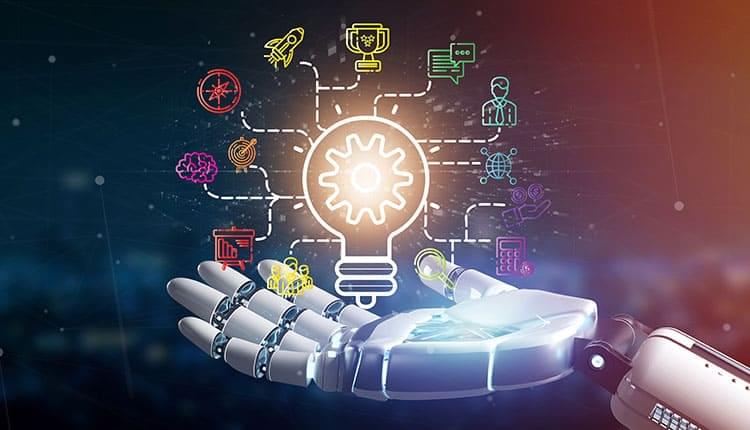AI is the undoubted buzzword of the year, so let’s take a look at what we can expect from AI in healthcare in the coming period.
Category: robotics/AI – Page 902
GPT-4 — How does it work, and how do I build apps with it? — CS50 Tech Talk
First, you’ll learn how GPT-4 works and why human language turns out to play such a critical role in computing. Next, you’ll see how AI-native software is be…


AI Turns Brain Waves into Spoken Words
Summary: Researchers achieved a breakthrough in converting brain signals to audible speech with up to 100% accuracy. The team used brain implants and artificial intelligence to directly map brain activity to speech in patients with epilepsy.
This technology aims to give a voice back to people in a locked-in state, who are paralyzed and cannot speak. The researchers believe that the success of this project marks a significant advance in the realm of Brain-Computer Interfaces.
Artificial Intelligence and manufacturing
Interview with Prof. Marc Sachon for the event “Artificial Intelligence: Using your power for good” (IESE Global Alumni Reunion 2022).
+ “Artificial Intelligence for Executives” Program:
https://execedprograms.iese.edu/strategic-management/artificial-intelligence/
+ “The Power of AI to Transforming Your Business Program:
https://execedprograms.iese.edu/strategic-management/artific…-business/
What is the next wave after artificial intelligence|The Singularity Is Near|#audiobooks
This book, ‘The Singularity Is Near’, predicts the future. However, unlike most best-selling futurology books, its author, Kurzweil, is a renowned technology expert. His insights into the future are not technocratic wild fantasies but are rooted in his profound contemplation of technological principles.
This audio informs us that, due to Moore’s Law, the pace of human technological advancement in the future will far exceed our expectations. By 2045, we will reach the technological ‘Singularity’, which will profoundly alter our human condition, and technology may even enable humans to conquer the universe within a millennium.
The author, Ray Kurzweil, is a true tech maestro. He has been inducted into the National Inventors Hall of Fame in the U.S., is a recipient of the National Medal of Technology, holds 13 honorary doctorates, has been lauded by three U.S. presidents, and is dubbed by the media as the ‘rightful heir to Thomas Edison’.
In the audio, you will hear:
Moore’s Law has been around for 40 years; can it continue?
Why is it said that by 2045, humans will reach a technological Singularity?
Why are future humans described as a set of algorithms?
Is artistic creation the last bastion between humans and artificial intelligence?
BookLink:https://amzn.to/45akzPk.
10 AI Tools THAT CHANGE EVERYTHING!
AI really is getting bigger, better and crazier, and in this video I’ll show you the top 10 AI tools that are changing EVERYTHING!! You Guys have gotta try them out and let me know in the comments which AI was your favorite one!
AI TEXT TO VIDEO — https://runwayml.com/
AI ART 2.0 — https://clipdrop.co/
AI MIXING — https://www.ostagram.me/
AI PHOTO EDITING — https://www.adobe.com/uk/products/photoshop/
AI EMAILS — https://workspace.google.com/labs-sign-up/
AI QR CODES — https://www.qrcraft.xyz/
AI DEEPFAKES — https://reface.ai/unboring/
AI WORLDS — https://skybox.blockadelabs.com/
AI TRANSFORMATION — https://wonderdynamics.com/
AI FOREVER — https://diffusionbee.com/
FREE WALLPAPERS
https://www.haylsworld.com/free-downloads.
🌟 SOCIAL 🌟
• SHORTS — https://www.youtube.com/c/HaylsWorldShorts.
• INSTAGRAM — http://instagram.com/haylsworld.
• TWITTER — https://twitter.com/HaylsWorld.
• WEBSITE — https://www.haylsworld.com/
🛒 AMAZON SHOP 🛒
https://www.amazon.com/shop/haylsworld?tag=lifeboatfound-20.
🎵 MUSIC 🎵
How Powerful Will AI Be In 2030?
🔒 Keep Your Digital Life Private and Stay Safe Online: https://nordvpn.com/safetyfirst.
Welcome to our channel! In this exciting video, we delve into the fascinating realm of artificial intelligence (AI) and explore the question that has intrigued tech enthusiasts and experts alike: “How powerful will AI be in 2030?” Join us as we embark on a captivating journey into the future of AI, examining the possibilities, advancements, and potential impact that await us.
In the next decade, AI is poised to revolutionize numerous industries and transform the way we live and work. As we peer into the crystal ball of technological progress, we aim to shed light on the potential power and capabilities that AI could possess by 2030. Brace yourself for mind-blowing insights and expert analysis that will leave you in awe.
We begin by exploring the current state of AI and its rapid advancements. From machine learning algorithms to neural networks and deep learning models, AI has already demonstrated exceptional prowess in various fields, including healthcare, finance, transportation, and more. By building upon these achievements, AI is set to evolve exponentially, opening doors to a future where intelligent machines collaborate seamlessly with humans.
Throughout this video, we delve into key areas where AI is expected to make significant strides by 2030. We discuss advancements in natural language processing, computer vision, robotics, and autonomous systems. Witness the potential of AI-powered virtual assistants, autonomous vehicles, medical diagnostics, and even the integration of AI in our daily lives.
To provide a comprehensive perspective, we draw insights from leading AI researchers, industry pioneers, and thought leaders who offer their expert opinions on the future trajectory of AI. Their invaluable insights help us paint a vivid picture of the exciting possibilities that await us in the next decade.
Join us on this thought-provoking journey into the future, as we ponder the ethical implications, challenges, and potential risks that arise with the growing power of AI. By understanding the trajectory of AI development, we can prepare ourselves for a future where humans and intelligent machines coexist harmoniously.

Jidoka Technologies announces the launch of the revolutionary Self-training Software for AI-based Object Detection
Jidoka Technologies, among the pioneers in the field of automated cognitive inspection for manufacturing, is happy to announce the launch of its innovative self-training software designed to revolutionise AI-based object detection techniques. In the era of rapidly evolving technologies, visual quality in manufacturing is not always binary – OK or NOK, and is highly subjective. It relies on people’s experience and expertise for decisions that need to be taken within seconds despite the presence of rules and SOP.
The criteria for accepting or rejecting defects in components can fluctuate due to factors like environmental conditions, the influence of external elements such as oil and dust on the part, and changes in standards based on the part’s functionality and its intended user. Although these variations are in the acceptable range, automated machine systems that rely on rule-based approaches would be rejecting the parts leading to a high percentage of false positives.
For over three years, Jidoka Technologies has been deploying its AI-driven software to address complex visual inspection tasks, with a track record of over 40 success stories spanning across automotive, consumer goods, print, and packaging industries. Customers have been asking for self-training for two use-cases, where there is a change in environment or variations for existing lines or where there is a high mix-low volume eg: the PCB industry where the requirements are dynamically changing. By building on this rich experience, the organisation is now introducing its self-training software, empowering customers with the ability to independently train and deploy AI models on the go.

What if AI becomes self-aware?
A glimpse into the dynamics between a man and a self-conscious machine.
Artificial Intelligence (AI) in a nutshell
Artificial intelligence (AI) and Cognitive robotics are the two stalwart fields of design and engineering, seizing all the spotlight lately. Artificial intelligence is a human intelligence simulation processed by machines, whereas cognitive robotics is the corollary of robotics and cognitive science that deals with cognitive phenomena like learning, reasoning, perception, anticipation, memory, and attention. Robotics is a part of AI, where the robots are programmed with artificial intelligence to perform the tasks, and AI is the program or algorithm that a robot employs to perform cognitive functions. In simpler terms, a robot is a machine, and AI is the intellect fuel fortified to ignite perceptual abilities in a machine.